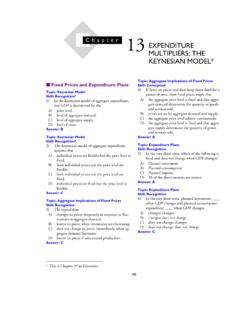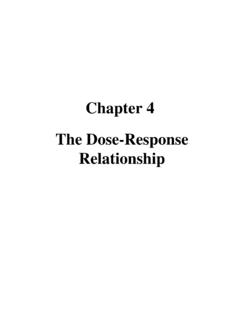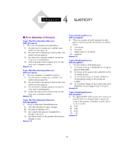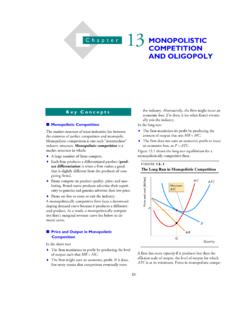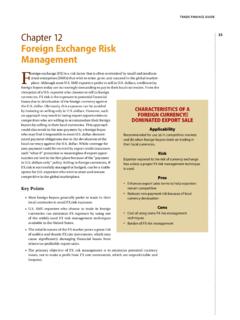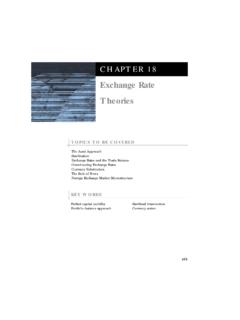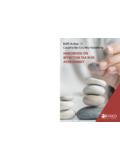Transcription of Macroeconomics, 10e, Global Edition (Parkin) …
1 1 Copyright 2012 Pearson Education macroeconomics , 10e, Global Edition ( parkin ) chapter 26 The Exchange Rate and the Balance of Payments 1 The Foreign Exchange Market 1) The term "foreign currency" refers to foreign I. coins II. notes III. bank deposits A) II only. B) II and III only. C) I and II only. D) I, II, and III. Answer: D Topic: Financing International Trade Skill: Recognition Question history: Previous Edition , chapter 9 AACSB: Reflective Thinking 2) If portable disk players made in China are imported into the United States, the Chinese manufacturer is paid with A) dollars. B) yuan, the Chinese currency. C) international monetary credits. D) euros, or any other third currency. Answer: B Topic: Financing International Trade Skill: Conceptual Question history: Previous Edition , chapter 9 AACSB: Reflective Thinking 3) If the United States sells beef to Japan, the beef producer is paid with A) dollars.
2 B) yen, the Japanese currency. C) international monetary credits. D) euros, or any other third currency. Answer: A Topic: Financing International Trade Skill: Conceptual Question history: Previous Edition , chapter 9 AACSB: Reflective Thinking 2 Copyright 2012 Pearson Education 4) When Safeway supermarkets in the United States buys strawberries from Mexico, A) it uses dollars to pay Mexican farmers. B) it uses pesos to pay Mexican farmers. C) it may use any currency it chooses. D) the transaction shows up in the capital account. Answer: B Topic: Financing International Trade Skill: Conceptual Question history: Previous Edition , chapter 9 AACSB: Reflective Thinking 5) Americans demand Japanese yen in order to A) buy Japanese products. B) supply American goods in Japanese markets. C) allow the Japanese to buy products. D) balance the current account.
3 Answer: A Topic: Financing International Trade Skill: Conceptual Question history: Previous Edition , chapter 9 AACSB: Reflective Thinking 6) Which of the following statements is correct? I. The exchange rate is a price. II. The exchange rate is different from other prices because it is NOT determined by supply and demand. A) only I B) only II C) I and II D) neither I nor II Answer: A Topic: The Exchange Rate Skill: Conceptual Question history: Previous Edition , chapter 9 AACSB: Reflective Thinking 7) The exchange rate is the A) opportunity cost of pursuing a nation's comparative advantage. B) price of one country's currency expressed in terms of another country's currency. C) ratio between imports and exports. D) interest rate that is charged on risk-free international capital flow. Answer: B Topic: The Exchange Rate Skill: Recognition Question history: Previous Edition , chapter 9 AACSB: Reflective Thinking 3 Copyright 2012 Pearson Education 8) The exchange rate is the price at which the _____ of one country exchanges for the _____ of another country.
4 A) currency; goods B) goods; goods C) currency; currency D) currency; financial instruments Answer: C Topic: The Exchange Rate Skill: Recognition Question history: Previous Edition , chapter 9 AACSB: Reflective Thinking 9) A decrease in the value of a currency in terms of other currencies is known as A) an appreciation. B) a depreciation. C) a par value. D) a gold point. Answer: B Topic: The Exchange Rate, Currency Depreciation Skill: Recognition Question history: Previous Edition , chapter 9 AACSB: Reflective Thinking 10) When the value of one currency falls relative to another currency, the exchange rate for the first currency has A) depreciated. B) appreciated. C) demanded. D) revalued. Answer: A Topic: The Exchange Rate, Currency Depreciation Skill: Recognition Question history: Previous Edition , chapter 9 AACSB: Reflective Thinking 11) By definition, currency depreciation occurs when the value of A) all currencies fall relative to gold.
5 B) one currency falls relative to another currency. C) one currency rises relative to another currency. D) gold falls relative to the value of currencies. Answer: B Topic: The Exchange Rate, Currency Depreciation Skill: Conceptual Question history: Previous Edition , chapter 9 AACSB: Reflective Thinking 4 Copyright 2012 Pearson Education 12) Suppose that the exchange rate between the dollar and the peso changed from 6 pesos per dollar to 8 pesos per dollar. This change means that the A) peso appreciated. B) dollar depreciated. C) peso depreciated. D) Both answers A and B are correct. Answer: C Topic: The Exchange Rate, Currency Depreciation Skill: Conceptual Question history: Previous Edition , chapter 9 AACSB: Reflective Thinking 13) If the dollar's value changes from 120 yen per dollar to 110 yen per dollar, the dollar has A) depreciated.
6 B) appreciated. C) demanded. D) devalued. Answer: A Topic: The Exchange Rate, Currency Depreciation Skill: Conceptual Question history: Previous Edition , chapter 9 AACSB: Reflective Thinking 14) Which of the following examples definitely illustrates a depreciation of the dollar? A) The dollar exchanges for 120 euros and then exchanges for 100 euros. B) The dollar exchanges for 100 euros and then exchanges for 120 yen. C) The dollar exchanges for 1 pound and then exchanges for pounds. D) The dollar exchanges for 250 yen and then exchanges for 275 euros. Answer: A Topic: The Exchange Rate, Currency Depreciation Skill: Conceptual Question history: Previous Edition , chapter 9 AACSB: Reflective Thinking 15) When the dollar depreciates against the yen, the yen becomes _____ expensive and the exchange rate _____. A) more; rises B) less; rises C) more; falls D) less; falls Answer: C Topic: The Exchange Rate, Currency Depreciation Skill: Conceptual Question history: Modified 10th Edition AACSB: Reflective Thinking 5 Copyright 2012 Pearson Education 16) When the dollar depreciates against the yen, the yen _____ and the exchange rate _____.
7 A) appreciates; rises B) depreciates; rises C) appreciates; falls D) depreciates; falls Answer: C Topic: The Exchange Rate, Currency Depreciation Skill: Conceptual Question history: Previous Edition , chapter 9 AACSB: Reflective Thinking 17) Last year the exchange rate between dollars and Mexican pesos was 10 pesos per dollar. Today is it 11 pesos per dollar. Here, the dollar _____ against the peso, and the peso _____ against the dollar A) appreciated; depreciated B) depreciated; appreciated C) appreciated; appreciated D) depreciated; depreciated Answer: A Topic: The Exchange Rate Skill: Conceptual Question history: Previous Edition , chapter 9 AACSB: Reflective Thinking 18) Suppose the exchange rate of the dollar was British pounds = $ ( ) on Wednesday, and on Monday the exchange rate was $.75 ( ) = British pound. Which of the following best describes what happened between Wednesday and Monday?
8 A) The dollar appreciated against the British pound. B) The British pound appreciated against the dollar. C) The dollar depreciated against the British pound. D) Both answers B and C are correct. Answer: D Topic: The Exchange Rate, Currency Depreciation Skill: Conceptual Question history: Previous Edition , chapter 9 AACSB: Reflective Thinking 6 Copyright 2012 Pearson Education 19) An increase in the value of a domestic currency in terms of other currencies is known as A) an appreciation. B) a depreciation. C) a flexible exchange rate. D) a term not given in the above answers. Answer: A Topic: The Exchange Rate, Currency Appreciation Skill: Recognition Question history: Previous Edition , chapter 9 AACSB: Reflective Thinking 20) Which of the following examples definitely illustrates an appreciation of the dollar? A) The dollar exchanges for 120 euros and then exchanges for 100 euros.
9 B) The dollar exchanges for 100 yen and then exchanges for 125 euros. C) The dollar exchanges for 1 pound and then exchanges for pounds. D) none of the above Answer: C Topic: The Exchange Rate, Currency Appreciation Skill: Conceptual Question history: Modified 10th Edition AACSB: Reflective Thinking 21) Suppose the exchange rate of the dollar was euro = $ on Thursday, and on Friday the exchange rate was $ = euros. Which of the following best explains what has happened between Thursday and Friday? A) The dollar appreciated against the euro. B) The euro appreciated against the dollar. C) The dollar depreciated against the euro. D) Both answers B and C are correct. Answer: A Topic: The Exchange Rate, Currency Appreciation Skill: Conceptual Question history: Previous Edition , chapter 9 AACSB: Reflective Thinking 22) If the pound-dollar exchange rate changes from per dollar to per dollar, then the pound has _____ against the dollar and the dollar has _____ against the pound.
10 A) depreciated; depreciated B) appreciated; depreciated C) appreciated; appreciated D) depreciated; appreciated Answer: D Topic: The Exchange Rate, Currency Appreciation Skill: Conceptual Question history: Previous Edition , chapter 9 AACSB: Reflective Thinking 7 Copyright 2012 Pearson Education 23) If 100 Japanese yen buy more dollars today than yesterday, the dollar has _____ and the yen has _____. A) depreciated; appreciated B) appreciated; depreciated C) depreciated; depreciated D) appreciated; appreciated Answer: A Topic: The Exchange Rate, Currency Appreciation Skill: Conceptual Question history: Previous Edition , chapter 9 AACSB: Reflective Thinking 24) If the value of a dollar rises in terms of yen, the dollar has _____ and the yen has _____. A) appreciated; appreciated B) appreciated; depreciated C) depreciated; appreciated D) depreciated; depreciated Answer: B Topic: The Exchange Rate, Currency Appreciation Skill: Conceptual Question history: Previous Edition , chapter 9 AACSB: Reflective Thinking 25) If the Japanese yen was 123 per dollar and now is 114 yen per dollar, it can be said that A) the yen appreciated against the dollar.

